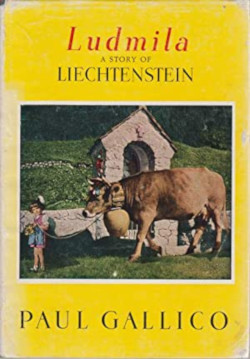The second set of writings is The Chronicles of a Conservationist which reveals many autobiographical tales of what a conservationist can experience throughout the world. Many but not all are pleasant experiences that may well be published in a second anthology.
One example of these tales is an expedition to Liechtenstein
Liechtenstein- the European Jewel
Like many people, I’ve just got back from my annual holiday and am still full of it all. I visited the Alpine principality of Liechtenstein, and asked the questions, was there any interesting wildlife in such a small and heavily populated country? If so, could I see them?
After a few days of rain the clouds lifted, the sun shone and the blue sky became an exalting dome. So we took immediate advantage of this and organised walks in the high mountain peaks, forests and lakes, away from people and the picturesque villages.
The first walk was above the tree line, near Malbun, the highest village in the country. During the first few hours I caught a glimpse of what seemed to be a large mountain rabbit. Gradually the rabbits became more visible as they rested and grazed. Later I identified the animals and found that they were not actually Alpine rabbits, but marmots. Moreover they are classified as ground squirrels. These are sociable animals that do not venture too far away from their interconnected burrows for safety reasons.
 |
| Birds of prey: seen all over this small country |
Before the walk had finished I also saw some huge birds of prey circling overhead. At first I had hoped that these raptors would be a rare type of eagle and therefore a ‘new species’ for me. Later I confirmed that they were buzzards, magnificent birds but alas no personal first as I had seen them before.
A few days later we went on a walk through the pastures and along the tree lined tracks of the beautiful Valorsch Valley. This Alpine trek remains one of my fondest memories, never to be forgotten. Here I saw my first chamois, a type of antelope &fgoat. It had upright button horns, a black and white badger-like face and its unmistakable brown summer coat.
This unexpected sighting was a real treat, especially as we managed to creep up on it without disturbing the animal. The chamois and I both stood still and studied each other; carefully, as if we were in a magical spell. Then, without a sound, its torso sank a little, its legs buckled slightly, and it sprung off into the dense trees just a few yards away. It was probably a solitary male, as I never saw another chamois anywhere nearby. At that time of year, most females would have been accompanied with a kid and been in a nearby herd of one or two dozen.
Just as we swung around from the mountainside on the last leg of the walk, I looked down to the Rhine Valley below. I was surprised to see a herd of red deer in an open glade, albeit far away.
| Wolf |
As I had managed to borrow some binoculars, I trained them on these creatures and noticed their remarkable red coats. The complete herd, with eight or nine does, five fawns, and three fully antlered stags, was relaxing. I saw them in their majesty, and whilst they were perhaps not ‘Monarchs of the Glen’, they were still the princes of these mountainsides.
We also saw garden and field birds that are found in Britain such as robins, blackbirds and many types of finches. I could not precisely identify some of the more unusual species, but they were probably of the warbler family. However these flitted away leaving me frustrated.
The best sighting was a crow-like bird that was jet black, except for a fine, long, yellow bill. I scrutinized the field guide and was astonished to find that it was a chough. I remembered that the choughs that I had previously seen along the British coast were red billed, and that this yellow billed bird was not the same species. It was a rarer Alpine breed - and this time a wonderful first for me. It was more than adequate compensation for not seeing an eagle a few days earlier.
The idyllic village of Masecha lay high in the mountains a few miles away (no place in Liechtenstein is more than a few miles away) where another writer, Paul Gallico once lived. His most famous book was the ‘Snow Goose’ although he also wrote a novella about Liechtenstein customs and transhumance entitled ‘Ludmilla’. It was in the neighbouring woods and glades where I saw my first ever ring ouzel, a member of the thrush family. Spotting this large and spectacular songbird gave me a real thrill as they only live in uplands. I recognised that it was a male because of its large brown body feathers, white half collared neck and paler coloured wings.

One unusual bird I spotted in the mountain streams and rivers at Steg, the village where we stopped, was the dipper. These birds are large wren-like birds with short wings. They have stout claws that grip the riverbed. Sadly I did not study them underwater; I would have loved to, as a dipper swims with its wings rather than its feet.
These waterways are fast-flowing, clean and fish free. So what do these birds feed on? Well, as their name suggests, the bird dips under the surface of water. It also swims over the riverbed rocks that create furious white water that is more powerful than gentler parts of the stream. The tumultuous waters stir up nutrients as well as larvae, insect life, and freshwater shrimps.
Indeed, I was absolutely shocked to catch one of these pink and white shrimps when I put my plastic beaker into a small waterfall for a clean drink of mountain water. It must have been a chance in million to have caught such a remarkably coloured animal, but it was perhaps the only way I could have seen one in the wild.
All in all, my hunch of taking a wildlife holiday in this gorgeous little Alpine Principality of Liechtenstein had been successful. Moreover there are even more exciting animals and rare Alpine flowers that I wasn’t able to see, and that warrants a return to Europe’s hidden jewel.

